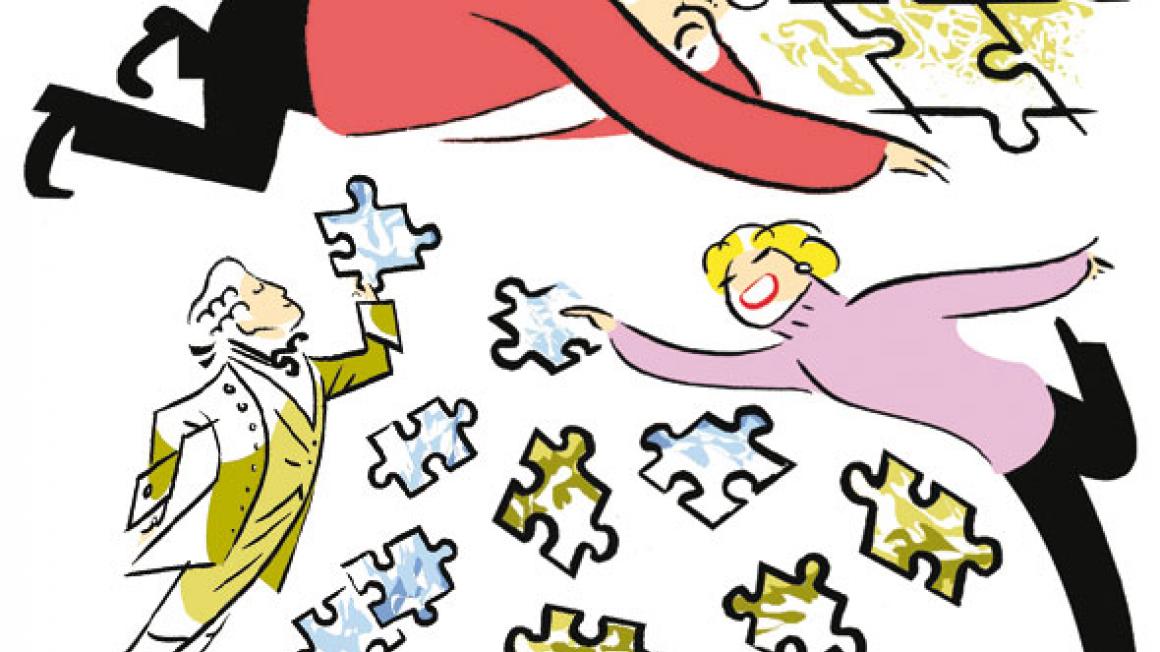Going to pieces...
Although John was only 30 when he died, he certainly left his mark; 250 years later, variations of his invention sell by the million. They’ve changed a bit, though. In the beginning, for example, wood was simply cut into shapes that fitted together, with no interlocking ‘toggles’. That familiar ‘jigsaw-piece’ shape was only created during the past 100 years.
Even once modern interlocking jigsaws came into fashion, early puzzles often had no straight edges, and so no helpful corner pieces, to create the frame. And unbelievably, there was no picture to guide people, either. ‘Jigsaw makers didn’t supply pictures of the finished puzzle until the 1920s,’ says Tom Tyler, known in the trade as Mr Jigsaw and author of British Jigsaw Puzzles Of The 20th Century.
What is it that Tom loves about jigsaws? ‘You start with chaos – a heap of wooden pieces – and gradually fit them together. Each piece you fit is a small triumph,’ he explains. ‘It’s therapeutic. If you’re worried or het up, a jigsaw will restore calm and give you a sense of perspective.’
Not surprisingly, Tom usually has a jigsaw on the go, and even makes his own, all the better to challenge his family with. ‘I’ve made one with 700 pieces and I used every trick in the book to make it difficult; straightedged pieces that fit in the middle; pieces that look as if they go in the middle but actually fit around the edge; hair that’s dissected by a jewelled headband, so it doesn’t appear to fit together...’ And of course no picture to help: ‘That would be cheating!’
Jigsaws tend to be family affairs, and none more so than for Enid Stocken, who cut her first jigsaw in 1915 and continued to make them until her death in 1983. Once described on BBC’s Antiques Roadshow as ‘one of the finest, if not the finest, jigsaw cutters of the 20th century’, her name and skill have been inherited by her son Peter, who runs Puzzleplex in South Yorkshire, the only makers of hand-cut jigsaws in the country. ‘I grew up in a welter of sawdust, and when my mother went out, I’d sneak a go on her treadle jigsaw machine,’ says Peter, now 70.
Today, he still hand-cuts jigsaws freehand, with no template as a guide, but using several ploys to make the puzzles as challenging as he can. His customers have included the Queen and Margaret Thatcher but he won’t name the celebrity who sent him a sepia-tint photograph of herself and her sister as children, and asked for it to be made into a jigsaw. ‘The sisters have a love-hate relationship,’ he says. ‘The one who was giving the present kept back six pieces in an envelope. When her sister had nearly finished the puzzle, and realised it was incomplete, she received a phone call which I’m told was unrepeatable!’
A few more bits and pieces
- The golden age of the jigsaw puzzle lasted from the late 19th century – when the invention of the treadle jigsaw allowed people to cut puzzles quickly and include intricate shapes – until 1939, when the outbreak of the Second World War meant that plywood was requisitioned.
- Famous jigsaw-lovers include the Queen (the Queen Mother was also a fan), footballer Michael Owen, actress Helena Bonham Carter, comedian and actor John Cleese, and the swimmer (and Olympic medal winner) Rebecca Adlington OBE, who loves the whole process of putting a jigsaw together: ‘You literally don’t think about anything else but finding this one picture,’ she says.
- During a difficult period when her husband Michael Holroyd was undergoing radiotherapy and chemotherapy, author Margaret Drabble decided to write a history of the jigsaw, even though she says she’s not very good at them: ‘It’s one of the reasons I like them so much.’ Her thoughts returned to childhood evenings spent doing jigsaws with her Aunty Phyllis.
- A ‘whimsy’ is a jigsaw piece cut into a recognisable shape, like a boat or a trumpet, and usually related to the theme of the puzzle’s picture.
- Wentworth Wooden Puzzles, one of the few wooden jigsaw manufacturers still cutting jigsaws in Britain, was founded in 1994 by Kevin Wentworth Preston, after his elderly mother asked him to find her an oldfashioned wooden jigsaw puzzle like the ones she remembered from childhood. Finding it difficult to find affordable puzzles of any quality, Kevin went into business making them.


